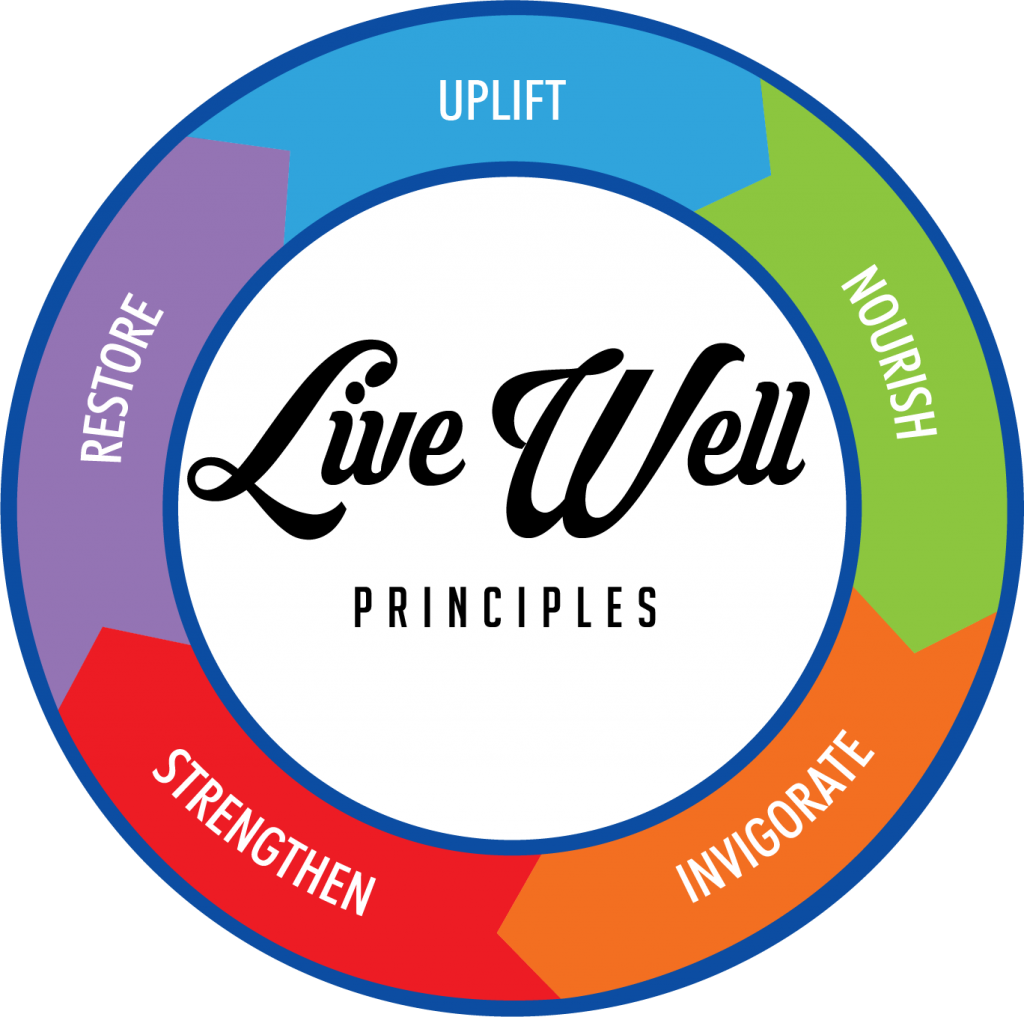
Lauren Parsons shares her principles for living well at work – and at home
Look around your office right now. The environment that you’re currently looking at can be turned into the office of your dreams. It can become a place where you and your colleagues are productive and stimulated, where you have brief standing meetings that create a positive start to the day, where you’re surrounded by healthy food that nourishes your body and mind, where movement is the norm, where you’re highly resilient, incredibly innovative and where everyone is engaged and excited to work together and produce the best work possible.
Regardless of your position or title, you are a leader. You’re the leader of your own life and you influence others. How you show up in the world matters.
My Live Well Principles

Here are my five principles, and six pillars within each, which will help you boost your health, energy and productivity:
Uplift
Think well, positive focus, attitude of gratitude, positive self-talk, constant learning, complete communication
Nourish
Eat real food, nutrient dense, positive relationships with food, cook fast, eat slow, savor food mindfully, hydrate
Invigorate
Active attitude, snack on exercise, add on intensity, sit less, move more, play, time outdoors
Strengthen
Strength train, quality vs. quantity, stand strong, build resilience, strong mind, social connection
Restore
Breathe, stay in rhythm, sleep well, restorative movement, trust, be present
As often as possible I encourage you to find ways to incorporate several different pillars in your daily life simultaneously. For example: you can start your day with a movement routine while breathing diaphragmatically and focusing on what you’re grateful for, covering the three pillars, Invigorate, Restore and Uplift. You can savour your lunch mindfully, focusing on being totally present and connecting with those around you, covering the three pillars Nourish, Restore and Strengthen.
The best thing about these five principles is that they not only apply to self but they can also be used in a work setting. When applied in the workplace, they help contribute to a productive, positive, energized environment where teams can perform at their best.
How? Let’s take a look:
1.Uplift
Encouragement and positivity work wonders when it comes to the workplace. When you encourage your co-workers and create a positive space that helps them to develop as a person, they respond by showing up as their best selves.
Immediate specific praise is one of the best strategies to lead and influence others because people naturally respond by doing more of what they are praised for. Be intentional and share positive feedback whenever you see the opportunity. You will influence those around you to lift their game in such a way that everyone benefits.
Gratitude has the power to take any moment and make it better. It can take the worst day and make it bearable, take an average day and make it good, and take a good day and make it extraordinary. By practicing gratitude and encouraging your workmates to focus on the things they’re grateful for, you can create a positive environment that people will be drawn to.
We also tend to get more of what we focus on, because of the way our brain is designed to scan the world for things in line with what our subconscious mind dwells on, so by focusing on what you’re grateful for, you get more of those things. This creates a positive spiral where you have even more things to be grateful for.
Clinical Psychologist Shawn Achor has shown that when our brain is in positive mode (rather than negative, neutral or stressed) we are also 31% more productive. That alone is reason to try it out and see what a difference it will make.
2. Nourish
Junk food has become commonplace in many work environments. However, this does not mean that it should be commonplace for you or your team. You have the power to influence positive change through your own behavior.
As the saying goes, ‘you are what you eat’. How often do you think about how what you eat makes you feel? Highly processed, convenience foods wreak havoc with your blood sugar levels, affecting how your brain functions and leaving you distracted, irritable and unable to focus.
Be sure to set yourself up for success by making it a priority to bring a healthy lunch each day. A small amount of preparation will pay big dividends. So will taking a break well away from your desk and getting natural sunlight into your eyes. You can help create a positive workplace culture around food by inspiring those around you to join you.
You may even like to start a ‘lunch club’ by agreeing with three colleagues that you’ll each have a set day once a week, Monday to Thursday to provide lunch for the four of you, with Friday as a day off/flexi day.
This means you only have to prepare something once a week in bulk, saving you both time and money. It also builds social connection and allows you to give back to others in a practical way. It can make lunchtime a highlight of your day looking forward to what’s on the menu. People are more creative and put in more effort, planning for and making up delicious soups, salads, wraps, quiches or some other healthy option to share.
3. Invigorate
Having a sedentary lifestyle, which is defined as six or more hours of sitting per day, increases both morbidity and mortality rates. Or in other words, if you sit for extended periods, you are more likely to get seriously ill earlier and to die younger. That remains true even if you exercise at other times, before or after work for example.
Not only that but sitting continuously trying to ‘work hard’ is inefficient. A 2019 study showed that people only achieve an average of 2.8 hours of productive work per day. Imagine if you could increase this by structuring your day differently. Breaking it into smaller sections and adding urgency to focused, uninterrupted periods and interspersing those with regular movement.
Set the trend and encourage those around you to move regularly throughout the day. Not only does movement improve your mood and make you feel energized, it has profound effects on your brain. A short movement burst can create a hormonal response which switches on the learning centres in your brain, increases your focus, and makes you more innovative and better at problem solving.
Make standing, moving, and engaging in short ‘deskercise’ routines the norm rather than sitting at a desk all day. Set a countdown timer giving yourself 25 minute blocks of focused productive time, interspersed with short movement breaks.
By being active throughout the day, people will be way more pumped and energetic, as well as faster, more creative, more accurate and remarkably more productive.
4. Strengthen
Stress is a natural part of life. In small quantities, it is healthy for us and drives us to accomplish more. Too much stress, on the other hand, has negative effects on our mental/physical health as well as our performance.
Provide hands-on tools to boost resilience and teach your team how to handle work-related stress so they have the coping skills necessary to deal with things that become too much for them.
Top sports people have mental conditioning coaches to help them perform at their peak. They teach techniques such as reframing the way we think about things, anchoring techniques, mindfulness and a strengths-based focus which all improve people’s emotional intelligence.
Having a framework in place in advance that supports people to strengthen their resilience is a great proactive approach to ensure everyone’s success. A stressed employee is not a happy or productive employee. A focused, resilient one is. It’s always worth investing time and effort into increasing resilience and mental strength.
5. Restore
You and your staff are not machines and cannot be expected to work as such. Make sure that you give your team, as well as yourself, enough downtime so that you can all be as productive as possible.
Take regular breaks outside in sync with your body’s natural ultradian rhythm which has an upswing of around 90 minutes followed by a downswing of around 20 minutes. These cycles repeat throughout the day and it’s vital to structure your time to work in sync with them to create flow rather than trying to work through each downswing.
Each time you feel tired, foggy-brained, irritated or distracted those are signals from your body that it’s time to take a break. You can choose to push through this and continue working, however your body will perceive this as a signal that you are in a life or death situation as you’re not listening to those clues to slow down, and as a result will put your nervous system into fight or flight mode, flooding your body with adrenaline, which gives you that ‘second wind’ feeling. This is acceptable from time to time, but on an ongoing basis has serious negative consequences for your health.
Even our mobile devices need to recharge regularly. Take time to recharge yourself. When you notice those physical and mental cues, remember that it’s more efficient to get outside and take a break, or to create some sort of change of state so you can start back refreshed and focused.
Productivity comes from smart work, not hard work.












